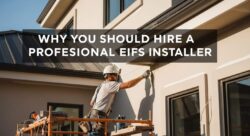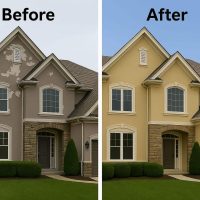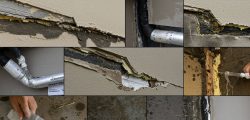The Ins and Outs of EIFS: Practical Advice and Proven Techniques for a Seamless Setup
Contemplating EIFS for your home? Know that you need an expert for it. Doing it wrong could cost you more down the line. Let’s dive into EIFS so you can be sure of your decisions. Learn the ins and outs to get a flawless installation.
Understanding EIFS (Exterior Insulation and Finish System)
EIFS, or Exterior Insulation and Finish System, is a construction technology that combines insulation with a decorative finish for exterior walls. It offers many benefits, such as increased energy efficiency, beautiful aesthetics and enhanced durability.
Components of EIFS:
- Insulation: Foam boards or panels attached to the outside wall surface.
- Base Coat: Applied on top of the insulation to strengthen the system.
- Reinforcement: Fiberglass mesh embedded in the base coat for extra strength.
- Finish Coat: Final layer that adds a visually pleasing finish.
EIFS has great details like thermal efficiency, moisture control and design flexibility. Additionally, it reduces heat transfer through walls, preventing water infiltration and structural damage. Plus, it enables creativity in building design.
To get a perfect EIFS installation:
- Hire certified installers – they have been trained and know best.
- Prepare the site well – clean the surface and be aware of the weather.
- Use good materials – quality insulation, base coat, reinforcement mesh and finish coat.
- Follow manufacturer instructions – for optimal performance.
Following these tips will help you get the most out of this amazing construction technology. Even the Mona Lisa would frown at a bad EIFS – it’s a face only a professional could love!
Why Professional Installation Matters
EIFS Application: Professional Installation is a Must!
Professionals are the only way to go for a flawless EIFS (Exterior Insulation and Finish System) installation. Skilled installers are equipped with the knowledge and experience to navigate potential challenges. Amateur installers may overlook crucial steps, resulting in costly mistakes that compromise the system’s integrity and performance.
Quality Assurance: Key to Reliable Performance
Relying on professionals means quality assurance. They adhere to industry standards, protocols and codes during every step of the process. This guarantees optimal performance and longevity of the EIFS system.
Technical Expertise: Unlocking Full Potential
Professionals provide more than just meeting minimum requirements. They have an in-depth understanding of different materials, techniques and finishes available in the market. This allows them to recommend tailored solutions, maximizing energy efficiency, durability and aesthetic appeal.
Attention to Detail: Achieving Flawless Outcome
Amateurs often neglect essential details. Professionals evaluate substrate conditions, choose adhesives and apply base coats and finish coats with precision. They pay attention to minor aspects such as moisture control and joint treatments, ensuring a seamless integration which reduces the risk of water infiltration or cracks.
Go Professional: Peace of Mind, Longevity & Performance
Investing in professional installation pays off. Experts with their technical expertise and commitment to quality ensure a flawless EIFS system that retains its aesthetic appeal for years to come. Don’t skip the pre-installation checklist – unless you want a moldy, crumbling exterior!
Pre-Installation Checklist for EIFS
Before starting an EIFS install, a pre-install checklist is essential for success. Covering all necessary preparation steps and site conditions, it’ll guarantee the project’s success. Here’s what to remember:
- Inspect and prep the surface – find any cracks, moisture damage, or deteriorated areas. Repair and get it ready for EIFS.
- Know local building codes – familiarize yourself with rules governing EIFS installs. Ensure your plans meet requirements to avoid legal issues.
- Choose right components – select materials and parts for your EIFS app. Consider weather-resistance, insulation, and aesthetic preferences.
- Inspect environmental factors – assess temperature, humidity, wind exposure, and water sources. These can significantly affect the install process and EIFS performance.
Proper flashing details are key in preventing water infiltration. Check that all flashing components are correctly installed with best industry practices. Invest time in pre-install prep for a successful EIFS install.
Pro Tip: Always refer to manufacturer guidelines and seek experienced pros advice when creating your EIFS project pre-install checklist. Prepare the EIFS substrate like you’re hosting a party for perfectionists – make sure every surface is smoother than a politician’s apology.
Best Practices for EIFS Substrate Preparation
Ensuring the perfect installation of EIFS is key. Substrate preparation is essential for this to happen. Cleaning the surface, repairing any damages, evaluating moisture levels, and applying bonding agent are all important steps. Unique details should also be taken into account for a flawless installation. The EIFS Industry Members Association (EIMA) states that proper substrate preparation is a must to guarantee long-term durability and performance of an EIFS system. If you’re ready to start with EIFS insulation, not to worry! We have expert advice to help you stay sane.
Expert Tips for EIFS Insulation Installation
EIFS (Exterior Insulation and Finish System) is an amazing way to boost energy efficiency in buildings. Here are 5 expert tips to get a perfect EIFS insulation installation:
- Ready the surface: Clean, dry and structurally sound substrate. Plus, repair cracks and damage for smoothness.
- Invest in top-quality materials: This will ensure durability and longer thermal layer system life. Also, better energy savings and insulation performance.
- Follow manufacturer instructions: Mixing ratios, application techniques and drying times must be respected.
- Careful attention to detail: Sealing and reinforcing corners, joints and edges is critical to avoid water infiltration and the keep the building envelope well-insulated.
- Experienced professionals: Knowledgeable installers have the expertise for a successful installation.
Climate conditions, building design and local regulations also need to be taken into account.
A commercial building experienced poor EIFS insulation installation. This caused significant heat loss, revealed during an energy audit. But, with professional help, the building drastically improved its energy efficiency and lowered heating costs.
Waterproofing and drainage are essential for a perfect EIFS installation. They’ll keep moisture out and protect it from any harm.
Ensuring Effective EIFS Waterproofing and Drainage
For a successful EIFS install, waterproofing and drainage solutions must be considered. Here are four points to keep in mind:- Choose the right moisture barrier: Get a flexible and durable barrier that won’t let water inside.
- Proper flashing: Make sure windows, doors, and other penetrations are properly flashed to prevent water penetration.
- Use sealants: Pick sealants designed for EIFS applications to protect against water intrusion at joints and transitions.
- Robust drainage systems: Install good drainage systems, including weep screeds and vents, to manage moisture.
Plus, inspect and maintain your EIFS system frequently to spot issues early and prevent major problems in the future. An example? A coastal building’s EIFS had water intrusion due to wrong flashing. Waterproofing and drainage changes solved this problem.
Follow these steps and invest in quality waterproofing and drainage for your EIFS. Want a perfect surface? Don’t mess it up, or you’ll have more cracks than a politician’s promises.
Finishing Techniques for a Perfect EIFS Surface
Achieving a seamless EIFS surface is paramount for enhancing its aesthetic appeal! Here are valuable tips to remember:
- Base Coat Application: Ensure a uniform texture by applying the base coat properly.
- Mesh Installation: Embed the reinforcing mesh completely within the base coat layer.
- Trowel Techniques: Use trowels with skill to achieve a smooth, even finish.
- Layering: Apply thin layers at regular intervals to prevent cracking.
- Detailing: Focus on corners, edges and transitions for an impeccable final result.
Apart from these, it’s vital to use high quality materials and follow manufacturer instructions for optimal performance. Understanding finishing techniques and honing your skills will guarantee a flawless surface. And as one contractor found out, mastering skilled trowel application led to an exceptional outcome that wowed their client. So don’t forget to pay attention to detail – it’s essential for perfection!
The Importance of Precise EIFS Detailing
The meticulousness of EIFS detailing is super important for achieving top-notch system performance. Paying attention to every single detail results in a smooth installation and boosts the EIFS system’s overall performance.
Correct EIFS detailing is essential for stopping moisture getting in, air leaks, and any potential damage to the system. From flashing installation to joint treatments, every aspect needs to be done with perfection to keep the EIFS system intact.
When it comes to openings like windows and doors, special attention is needed. Properly weaving these areas into the EIFS system guarantees a seamless transition and eliminates any weak points where moisture can sneak in. Penetrations through the EIFS layer, such as pipes or electrical outlets, must also be sealed properly.
Interior details can’t be overlooked either. Transition points like where EIFS meets other wall finishes or ceilings must be treated with care to maintain continuity and stop any visible defects or gaps.
By focusing on accurate EIFS detailing, issues can be prevented during construction and system performance can be maximized in the long run. Make sure every part of the project gets the right attention and expertise for a totally spotless installation that stands the test of time.
Don’t miss out on getting an impeccable EIFS installation by ignoring the need for precise detailing. Make use of expert tips and advice to enhance system performance while steering clear of future problems caused by poor detailing. Relying on pros experienced in EIFS installations will save you money, time, and hassle in the long run. So go ahead and get those chainsaws flaming, unicycle riding, tightrope walking skills ready – you’re going to need them!
Navigating EIFS Installation in Challenging Weather
EIFS Installation in Challenging Weather
Installing EIFS can be tricky, especially with bad weather. Here’s a 4-step guide to help you get it done right:
- Prep the substrate: Make sure the surface is clean, dry, and free of contaminants. Essential for a solid foundation for the EIFS system.
- Monitor temperature and humidity: Pay attention to both temperature and humidity during installation. High temps or humidity can affect the curing time of adhesives and coatings.
- Adjust installation methods: Use modified techniques to accommodate the weather. For example, pre-heat insulation boards in cold temps to improve adhesive bonding.
- Inspect regularly: Keep an eye on the progress and look for signs of damage or failure due to weather. Fix issues quickly to avoid more problems.
When installing EIFS, consult experts and follow manufacturer guidelines. Oh, and remember: the only thing scarier than a faulty EIFS installation is forgetting the stove was on before leaving the house. Fun fact: NAHB says EIFS accounts for 30% of residential claddings in North America.
Safety Considerations During EIFS Installation
It’s important to prioritize safety during EIFS installation. Here are key considerations to keep in mind:
- Employee Safety: Provide gloves, goggles, and masks to protect against hazardous materials.
- Fall Protection: Use guardrails or harnesses to prevent accidents from elevated surfaces.
- Electrical Safety: Take precautions when working with electrical equipment. Follow wiring and grounding practices.
- Fire Safety: Use fire-resistant materials and ensure fire exits are accessible.
Conduct regular inspections to identify potential hazards. Adhere to safety considerations for a secure work environment and a successful EIFS installation. Make sure to follow recommended guidelines and provide a safe working environment for your team – their protection should be top priority.
How to Comply with Building Codes and Regulations
To stick to building codes and regulations, it’s super important to make sure safety standards are followed. To guarantee a smooth installation process, do the following:
- Learn local building codes well.
- Get the necessary permits from the right authorities.
- Follow manufacturers’ instructions exactly.
- Inspect the construction site regularly.
- When needed, get help from experts who know the codes inside out.
Ensuring compliance with building codes and safety standards is essential, but so is high-quality workmanship and attention to detail.
Fun fact: The National Association of Home Builders report that 80% of home builders think following building codes is a must for public safety.
Watch out for those ‘EFS’ installers who made a big mistake and forgot the ‘I’ in EIFS, transforming it into ‘Extra Failure System’!
Addressing Common EIFS Installation Mistakes
Choose high-quality materials, apply proper techniques and inspect regularly to avoid EIFS installation issues. Get expert advice tailored to your project needs.
According to the Journal of Architectural Engineering Technology, addressing mistakes can prolong the system’s lifespan. To stay on top of things, keep your EIFS in tip-top shape – just like blocking your ex’s contact!
Post-Installation EIFS Care and Maintenance
Regular cleaning helps keep EIFS looking good and prevent dirt and grime. Use a soft brush or sponge with mild detergent or specialised EIFS cleaners.
Inspect regularly for cracks, gaps or damage to the EIFS system. Quick repairs can stop moisture getting in and causing further damage.
Professional maintenance is important. Get professionals to inspect, repair and give advice for optimal care.
Make sure drainage is good to stop water collecting and sort out any landscaping issues that could affect the EIFS system. Pro Tip: Monitor the performance of your EIFS by having a professional evaluation every few years.
The future of EIFS installation looks promising, with new tools and methods that would even amaze Spider-Man!
The Future of EIFS Installation: New Tools and Techniques
EIFS installation is always evolving with new tools and techniques emerging. Innovations in technology and installation methods are the future of this process.
Cutting-Edge Advancements in EIFS Installation
| Tools | Techniques |
|---|---|
| Spray guns | Advanced adhesive mix |
| Precision trowels | Moisture control |
| Efficient mixers | Reinforcement mesh |
| Digital moisture meters | Computerized design |
| Energy-efficient compressors | Weatherization systems |
Using eco-friendly materials and improving energy efficiency are just some of the unique features of EIFS installation. All of these elements lead to better aesthetics, durability, and performance.
Be ahead of the game! Get familiar with these new tools and techniques to make the most of EIFS installation. Don’t miss out on the chance to get a perfect finish while staying up-to-date on industry trends.
Frequently Asked Questions
What is EIFS?
EIFS stands for Exterior Insulation and Finishing System. It is a type of exterior wall cladding system that provides insulation and a decorative finish for buildings.
How is EIFS installed?
EIFS is installed by applying layers of insulation board and a base coat to the exterior wall surface. This is followed by the application of a reinforcement mesh and a final colored finish coat.
What are the advantages of EIFS?
EIFS offers several advantages, including improved energy efficiency, enhanced durability, increased thermal resistance, and design flexibility. It also helps to reduce air infiltration and noise transmission.
Can EIFS be applied to all types of buildings?
EIFS can be applied to most types of buildings, including residential homes, commercial buildings, and industrial structures. However, it is important to consult with a professional to ensure proper installation and compatibility.
How long does EIFS last?
With proper installation and maintenance, EIFS can last for several decades. The lifespan of EIFS can vary depending on factors such as climate conditions, maintenance practices, and quality of installation.
Is EIFS fire-resistant?
EIFS is non-combustible and does not contribute to the spread of fire. However, it is important to use fire-resistant materials and meet local building codes to ensure overall fire safety of the building.




